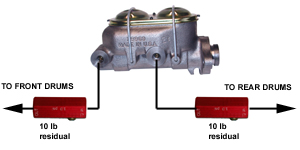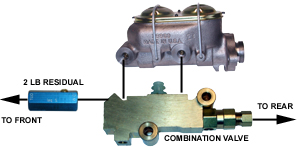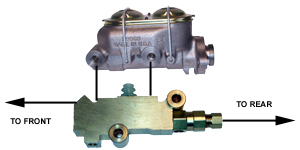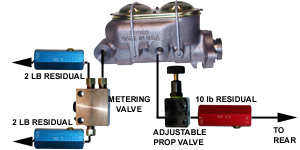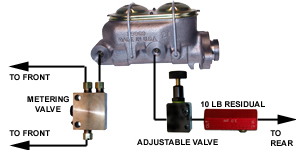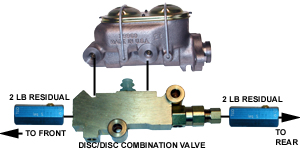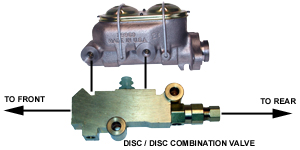
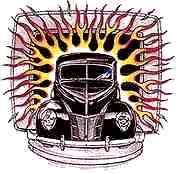
The home of Australian Hot Rodding on the Net
Step 8: BrakesDisc / Drum Set-Up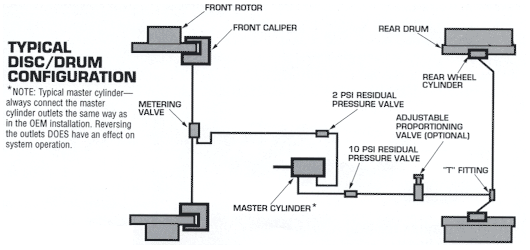
Disc / Disc Set-Up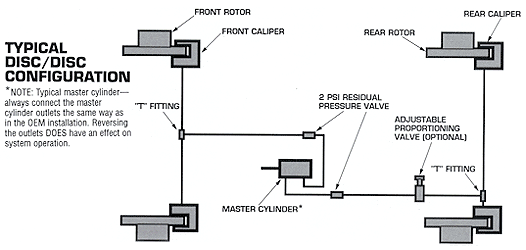
Correct Valve Installations
VALVING In order for your braking system to function properly the system must be properly balanced. This is accomplished through the use of the correct valves. Below is a description of what types of valving may be used on your system. HOLD-OFF / METERING VALVE are used in the front (disc) system of a disc/drum brake system. The metering or hold off valve is used in the brake system to better balance the front to rear brakes. They provide a "hold off" function to allow the rear (drum) brakes to actuate first. The valve does not allow the pressure to rise at the front disc brakes until the pressure at the rear drums has risen sufficiently to overcome the brake shoe springs. This function is very important in making the system function in the correct sequence in a rear wheel drive car. The rear brakes are always actuated first. At this point the valve opens to allow full pressure to build at the front brakes. This function is built into most factory type disc/drum combination valves. Make sure you have a metering/hold-off valve in the system either as a stand alone valve or as part of a factory valve. RESIDUAL VALVE There are two different residual valves. A ten pound residual valve will maintain a line pressure to the rear to keep the drum brake shoes out close to the drums giving a higher firmer pedal. Without a ten pound residual pressure to the rear you will experience a spongy pedal. A two pound residual valve is required whenever the master cylinder is lower than the calipers to prevent backflow of fluid from the calipers to the master. 
Residual Pressure Valves are used in a both front and rear brake system as follows:
COMBINATION VALVE A combination valve incorporates metering, proportioning and 10 pound residual into one valve. These are available for disc/drum or drum/drum systems. PROPORTIONING VALVE go in the rear brake system (disc or drum) and provide for control of the rate of pressure rise to the rear brakes -- just the rate at which it builds up. Sooner or later the rear brakes see full master cylinder discharge pressure. The proportioning valve modulates the pressure to the rear brakes. The modulation is necessary to minimize rear wheel lock up found in heavy braking and to compensate for the differences in braking conditions in front disc / rear drum systems. The purpose of this rate of pressure rise control is to compensate for the reduction of weight on the rear wheels due to forward weight transfer during braking. As pressure is applied to the system full pressure is allowed to the rear drums up to a certain point. Beyond that point the pressure to the rear is reduced preventing rear brake lock up. In short, it eases the application of the rear brakes to help prevent rear wheel lockup. Factory combination valves have these built in -- make sure you know what you're getting, too little rate of rise is as bad as too much. You may not need one of these valves depending on the compatibility of your vehicle's brake system components. ADJUSTABLE PROPORTIONING VALVE allow for fine tuning of the rate of pressure rise to the rear brakes if you have a lock up problem. If you have a lockup problem, experiment with the setting of the valve to eliminate lock up for all but all out panic stops. Good luck!ADJUSTABLE PROP VALVE The adjustable proportioning valve is used when you have a special rear condition that requires higher or lower pressure than a normal condition. You sould always use a metering valve to the front when using the adjustable 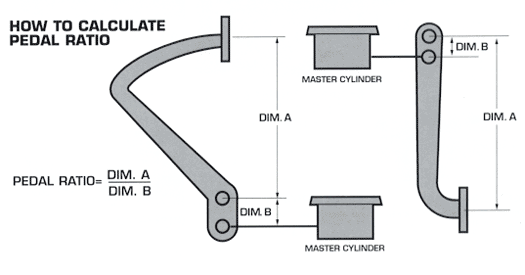 Frequently Asked QuestionsHow does a brake booster work? A power booster uses atmospheric pressure to help assist the pushing of the master cylinder piston. Basically, a power booster is divided into two chambers internally with a rubber diaphragm seperating each. With no force applied to the booster there will be vacuum on both sides of the diaphragm. This vacuum is supplied by the engine either from the intake manifold or the back of the carburetor. When you press on the pedal, the rod opens a poppit valve in the booster that allows atmospheric pressure on the firewall side of the diaphragm. This causes the diaphragm to push on the master cylinder piston thru a plastic hub, providing power assist to the master cylinder. 
|
|
Last Updated: 11/08/2002. Copyright © 1996-2004 by
HIGH PERFORMANCE WEB SITES, all rights reserved. All other trademarks, tradenames and/or service marks are the property of their respective holders. Copyright © 1996-2004 Hot-Rod Internet All Rights Reserved. Please read our Disclaimer , Terms and Conditions and Privacy Policy |
